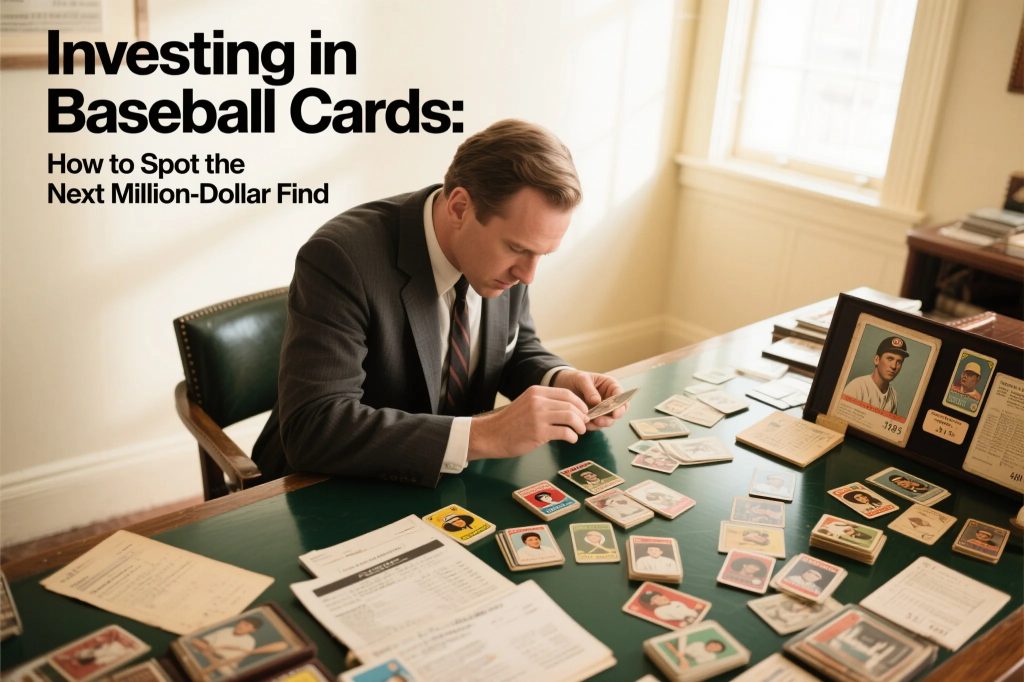
the new era of baseball cards as alternative assets
The market for sports cards has undergone a remarkable transformation in recent years, with rare baseball collectibles now commanding prices that rival blue-chip stocks and prime real estate. What was once considered childhood nostalgia has emerged as a legitimate investment strategy for savvy collectors and investors alike. The 2021 sale of a 1952 Mickey Mantle card for $12.6 million shattered previous records and brought mainstream attention to the potential of rare cards as stores of value. This watershed moment marked the beginning of a new era where baseball cards are viewed not just as collectibles but as serious vehicles for asset appreciation.
What makes baseball cards particularly compelling as investments is their unique combination of scarcity, cultural significance, and tangible nostalgia. Unlike stocks or bonds, the supply of vintage cards is fixed – no more 1933 Goudey Babe Ruth cards will ever be produced. Meanwhile, demand continues growing as successful professionals who collected as children enter their peak earning years. The market has also benefited from professional grading services that authenticate cards and assign condition ratings, creating standardized metrics that facilitate confident transactions. For investors seeking diversification beyond traditional assets, high-grade vintage baseball cards offer low correlation with financial markets while providing the intangible joy of owning pieces of sports history.
understanding the baseball card grading ecosystem
The advent of third-party grading has been the single most important development in establishing sports cards as legitimate investment strategy assets. Companies like PSA (Professional Sports Authenticator), SGC (Sportscard Guaranty), and Beckett Grading Services evaluate cards on a 1-10 scale, assessing factors like centering, corners, edges, and surface quality. The difference between a PSA 8 and PSA 9 can mean hundreds of thousands of dollars in asset appreciation potential for key rare cards. A 1952 Topps Mickey Mantle in PSA 9 recently sold for $5.2 million, while a PSA 8 of the same card might fetch “only” $1 million.
Serious investors need to understand several nuances of the grading system. The population reports showing how many examples exist at each grade level significantly impact valuations – a card that’s rare in high grade commands exponential premiums. “Qualifiers” for specific condition issues (like MC for miscut or ST for stain) can dramatically affect prices. Registry sets – where collectors compete to assemble the highest-graded sets – create additional demand at the very top of the condition spectrum. The most sophisticated investors track grading company preferences within the hobby; while PSA dominates the post-war market, SGC is often preferred for pre-war tobacco cards.
key eras and their investment potential
The baseball collectibles market divides into distinct historical periods, each with different risk/reward profiles. The pre-war era (before 1941) includes the most historic and scarce cards but carries the highest prices – a 1909-11 T206 Honus Wagner in top condition could approach $10 million. The post-war boom (1948-1975) offers slightly better availability with tremendous cultural significance, including the iconic 1952 Topps and 1954 Bowman sets. The modern era (1980s-present) requires more selective collecting but can produce outsized returns when identifying future Hall of Famers early in their careers.
Within these eras, certain categories consistently drive asset appreciation: rookie cards of legendary players, scarce high-number series cards, and unusual variations or errors. The most successful investors develop specialized knowledge in particular niches, recognizing that the market for rare cards behaves differently than traditional investments. For example, Hall of Fame inductions can cause sudden spikes in a player’s cards, while performance slumps might create buying opportunities. Current trends show growing interest in pioneering minority players like Jackie Robinson and Roberto Clemente, whose cards carry both financial and historical significance.
market dynamics and valuation factors
Unlike traditional securities, sports cards derive their value from a complex interplay of player legacy, condition rarity, and collector psychology. The most valuable cards typically share three characteristics: they feature iconic players, represent important issues (often rookie cards), and exist in exceptionally high grades relative to the surviving population. Market valuations follow nonlinear trajectories – a card might trade sideways for years before a career milestone or biographical film triggers exponential growth. The 2017 documentary on Ted Williams caused significant asset appreciation for his key issues.
The emergence of comprehensive sales databases has brought transparency to baseball collectibles pricing, but the market still requires specialized knowledge. Auction results from Heritage, Robert Edward Auctions, and Goldin often set new benchmarks. Private sales through dealer networks account for significant high-end volume. As more investors incorporate cards into their investment strategy, we’re seeing more sophisticated valuation models that account for factors like player legacy scores and comparable sales trajectories.

building a diversified card portfolio
Approaching sports cards as an investment strategy requires the same disciplined diversification as traditional assets. A well-constructed portfolio might include: 50% foundational post-war rookies (1954 Hank Aaron, 1955 Roberto Clemente), 30% pre-war stars in lower grades (1933 Goudey Babe Ruth), and 20% modern potential (2001 Ichiro Suzuki). The grading distribution should balance high-grade showpieces with more affordable mid-grade examples of important cards.
Player diversification is equally important – while Mickey Mantle cards dominate the market, savvy collectors identify undervalued legends like Sandy Koufax or Warren Spahn. Condition rarity plays a key role; for some issues, a PSA 5 might represent the sweet spot between affordability and investment quality. As with any alternative asset class, the ideal mix depends on an investor’s time horizon, risk tolerance, and passion for the hobby. Many successful collectors focus on completing specific sets or player runs rather than chasing every hot card.
preservation and risk management techniques
Protecting the value of baseball collectibles requires specialized preservation methods. Professional grading encapsulation provides the first line of defense, but additional protection comes from climate-controlled storage with stable temperature and humidity. Light exposure is particularly damaging to card surfaces and colors. Many serious collectors use museum-quality storage solutions or professional vault services that offer both physical protection and insurance coverage.
Market-related risk management is equally important. Seasoned investors maintain cash reserves to capitalize on market corrections when other collectors become forced sellers. They implement position sizing rules to prevent overexposure to any single player or era. Some employ options-like strategies, selling duplicates when prices spike while retaining core holdings. The most successful collectors combine passion with discipline, never allowing emotional attachment to override sound investment principles when evaluating rare cards.
liquidity considerations and exit strategies
While high-end sports cards offer surprising liquidity for baseball collectibles, transaction timelines vary by grade and rarity. Seven-figure cards can sell at auction within months, though auction houses typically charge 15-20% buyer’s premiums. The most liquid segment consists of certified key cards in the $10,000-$100,000 range – valuable enough to attract serious buyers but not so expensive as to limit the purchaser pool.
Sophisticated investors develop multiple exit channels before acquiring significant positions. These might include relationships with specialty dealers, standing orders with auction houses, and participation in collector forums. Some utilize buyback agreements with original sellers or consignment arrangements. Unlike many alternative assets, graded cards benefit from established standards that facilitate remote transactions, though in-person inspection remains preferable for high-value purchases.
the future of baseball card investing
The sports cards market stands at an interesting juncture as it transitions from hobby to recognized investment strategy. Several trends suggest continued maturation: institutional capital entering through collectible funds, financial advisors allocating to graded cards, and blockchain technology enabling new ownership models. At the same time, the market remains grounded in sports fandom, with career milestones and anniversaries continually renewing interest in classic players.
Forward-looking investors are positioning for several developments: increased international participation as baseball’s global popularity grows, greater emphasis on pioneering players from diverse backgrounds, and potential financial products tied to card indices. As the market evolves, one constant remains: the most valuable rare cards will always be those that capture iconic moments in baseball history while existing in exceptional states of preservation – a combination that becomes increasingly scarce with each passing decade.